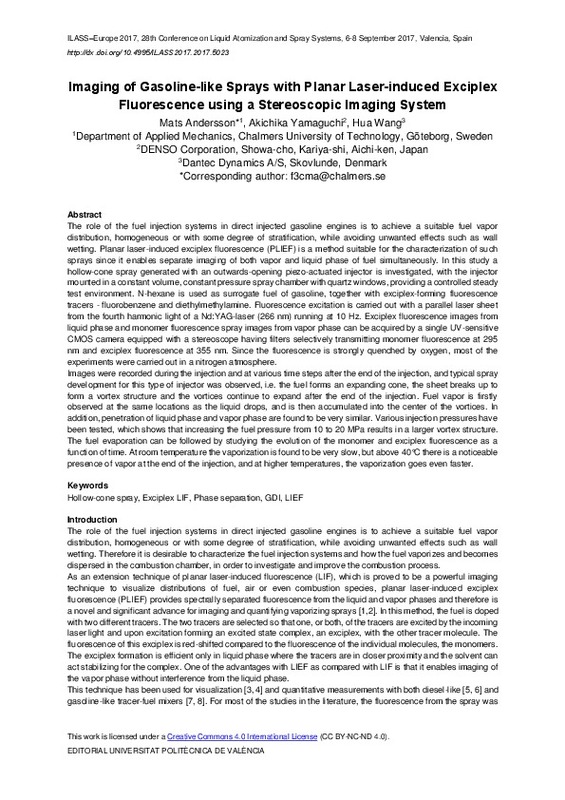JavaScript is disabled for your browser. Some features of this site may not work without it.
Buscar en RiuNet
Listar
Mi cuenta
Estadísticas
Ayuda RiuNet
Admin. UPV
Imaging of gasoline-like sprays with planar laser-induced exciplex fluorescence using a stereoscopic imaging system
Mostrar el registro sencillo del ítem
Ficheros en el ítem
| dc.contributor.author | Andersson, Mats
|
es_ES |
| dc.contributor.author | Yamaguchi, Akichika
|
es_ES |
| dc.contributor.author | Wang, Hua
|
es_ES |
| dc.date.accessioned | 2018-03-28T11:04:29Z | |
| dc.date.available | 2018-03-28T11:04:29Z | |
| dc.date.issued | 2017-07-28 | |
| dc.identifier.isbn | 9788490485804 | |
| dc.identifier.uri | http://hdl.handle.net/10251/99853 | |
| dc.description.abstract | [EN] The role of the fuel injection systems in direct injected gasoline engines is to achieve a suitable fuel vapor distribution, homogeneous or with some degree of stratification, while avoiding unwanted effects such as wall wetting. Planar laser-induced exciplex fluorescence (PLIEF) is a method suitable for the characterization of such sprays since it enables separate imaging of both vapor and liquid phase of fuel simultaneously. In this study a hollow-cone spray generated with an outwards-opening piezo-actuated injector is investigated, with the injector mounted in a constant volume, constant pressure spray chamber with quartz windows, providing a controlled steady test environment. N-hexane is used as surrogate fuel of gasoline, together with exciplex-forming fluorescence tracers - fluorobenzene and diethylmethylamine. Fluorescence excitation is carried out with a parallel laser sheet from the fourth harmonic light of a Nd:YAG-laser (266 nm) running at 10 Hz. Exciplex fluorescence images from liquid phase and monomer fluorescence spray images from vapor phase can be acquired by a single UV-sensitive CMOS camera equipped with a stereoscope having filters selectively transmitting monomer fluorescence at 295 nm and exciplex fluorescence at 355 nm. Since the fluorescence is strongly quenched by oxygen, most of the experiments were carried out in a nitrogen atmosphere. Images were recorded during the injection and at various time steps after the end of the injection, and typical spray development for this type of injector was observed, i.e. the fuel forms an expanding cone, the sheet breaks up to form a vortex structure and the vortices continue to expand after the end of the injection. Fuel vapor is firstly observed at the same locations as the liquid drops, and is then accumulated into the center of the vortices. In addition, penetration of liquid phase and vapor phase are found to be very similar. Various injection pressures have been tested, which shows that increasing the fuel pressure from 10 to 20 MPa results in a larger vortex structure. The fuel evaporation can be followed by studying the evolution of the monomer and exciplex fluorescence as a function of time. At room temperature the vaporization is found to be very slow, but above 40°C there is a noticeable presence of vapor at the end of the injection, and at higher temperatures, the vaporization goes even faster. | es_ES |
| dc.description.sponsorship | Financial support was obtained from the Combustion Engine Research Centre (CERC) at Chalmers, and the Swedish Energy Agency. The imaging system was provided by Dantec Dynamics. Stimulating discussions with Petter Dahlander are gratefully acknowledged. | es_ES |
| dc.format.extent | 7 | es_ES |
| dc.language | Inglés | es_ES |
| dc.publisher | Editorial Universitat Politècnica de València | es_ES |
| dc.relation.ispartof | Ilass Europe. 28th european conference on Liquid Atomization and Spray Systems | es_ES |
| dc.rights | Reconocimiento - No comercial - Sin obra derivada (by-nc-nd) | es_ES |
| dc.subject | Hollow-cone spray | es_ES |
| dc.subject | Exciplex LIF | es_ES |
| dc.subject | Phase separation | es_ES |
| dc.subject | GDI | es_ES |
| dc.subject | LIEF | es_ES |
| dc.title | Imaging of gasoline-like sprays with planar laser-induced exciplex fluorescence using a stereoscopic imaging system | es_ES |
| dc.type | Capítulo de libro | es_ES |
| dc.type | Comunicación en congreso | es_ES |
| dc.identifier.doi | 10.4995/ILASS2017.2017.5023 | |
| dc.rights.accessRights | Abierto | es_ES |
| dc.description.bibliographicCitation | Andersson, M.; Yamaguchi, A.; Wang, H. (2017). Imaging of gasoline-like sprays with planar laser-induced exciplex fluorescence using a stereoscopic imaging system. En Ilass Europe. 28th european conference on Liquid Atomization and Spray Systems. Editorial Universitat Politècnica de València. 546-552. https://doi.org/10.4995/ILASS2017.2017.5023 | es_ES |
| dc.description.accrualMethod | OCS | es_ES |
| dc.relation.conferencename | ILASS2017 - 28th European Conference on Liquid Atomization and Spray Systems | es_ES |
| dc.relation.conferencedate | September 06-08,2017 | es_ES |
| dc.relation.conferenceplace | Valencia, Spain | es_ES |
| dc.relation.publisherversion | http://ocs.editorial.upv.es/index.php/ILASS/ILASS2017/paper/view/5023 | es_ES |
| dc.description.upvformatpinicio | 546 | es_ES |
| dc.description.upvformatpfin | 552 | es_ES |
| dc.type.version | info:eu-repo/semantics/publishedVersion | es_ES |
| dc.relation.pasarela | OCS\5023 | es_ES |
| dc.contributor.funder | Chalmers University of Technology | |
| dc.contributor.funder | Swedish Energy Agency |








